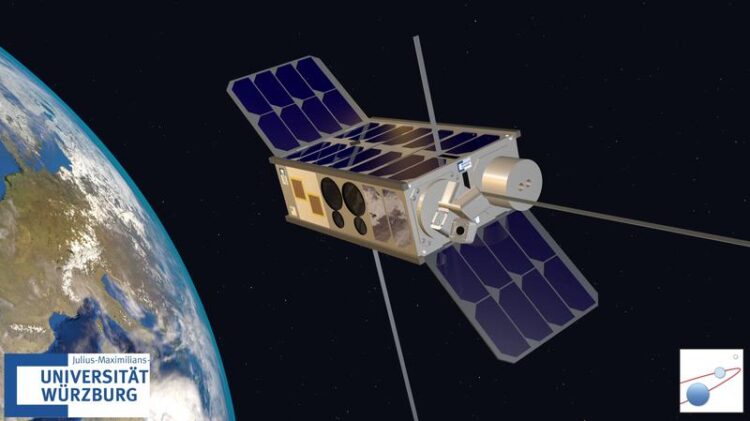Würzburg Nanosatellite to Test Novel AI Technologies

A model of the SONATE-2 nanosatellite, here artistically depicted in orbit.
(c) Hakan Kayal / University of Würzburg
A new Würzburg space mission is on the home straight: The SONATE-2 nanosatellite will test novel artificial intelligence hardware and software technologies in orbit.
After more than two years of development, the nanosatellite SONATE-2 is about to be launched. The lift-off into orbit by a rocket is expected in March 2024. The satellite was designed and built by a team led by aerospace engineer Professor Hakan Kayal from Julius-Maximilians-Universität (JMU) Würzburg in Bavaria, Germany.
JMU has been developing small satellite missions for around 20 years. SONATE-2 now marks another high point.
The satellite will test novel artificial intelligence (AI) hardware and software technologies in near-Earth space. The goal is to use it to automatically detect anomalies on planets or asteroids in the future. The Federal Ministry of Economic Affairs is funding the project with 2.6 million euros.
Training the AI on Board the Satellite
Comparable projects are few and far between, says Hakan Kayal: “What is unique about our mission is that the AI is trained on board. Normally, this training is done on Earth with powerful computers. But this strategy does not fit the plans the JMU professor has in mind.
Kayal gives an example: “Let’s assume that a small satellite is to investigate a new asteroid in the solar system in the future. It cannot be trained for this task on the ground, because the object of investigation is largely unknown. There is no training data, so the measurements and recordings have to be made on the ground.”
Sending this data to Earth first and then training the AI by remote control would take a long time for missions far from Earth. A higher level of autonomy supported by AI directly on board would be more powerful. It would lead to interesting objects and phenomena on the asteroid being detected much more quickly.
SONATE-2 Tests Many Other Technologies
Kayal’s team wants to test whether such scenarios can be realised in principle on SONATE-2 using newly developed procedures and methods, initially in Earth orbit. Four cameras on board provide the images needed for the training: The AI first learns about conventional geometric patterns on the Earth’s surface. This knowledge then helps it to find anomalies on its own.
On board SONATE-2 are other small satellite technologies that are to be tested in orbit. Among them are a system for the automatic detection and recording of lightning as well as an electric propulsion system, which was developed in cooperation with the University of Stuttgart. “In terms of complexity, SONATE-2 is unparalleled among nanosatellites,” says Kayal.
Mission Control Centre on the University Campus
If the project continues to go according to plan, SONATE-2 will launch into orbit on a SpaceX rocket from the west coast of the USA in March 2024. In recent weeks, the satellite has proven that it can withstand the extreme conditions of a space mission during various endurance tests. In a launch simulation, for example, all screws, soldered joints and glued connections withstood the enormous mechanical stresses of a rocket launch.
SONATE-2 is a so-called 6U+ cubesat model. It is about the size of a shoebox and has a mass of around 12 kilograms.
After the launch, communication with the satellite will take place from Würzburg. As with the previous SONATE model, this satellite will be operated by the Mission Control Centre on the Hubland campus. The team is aiming for an operating time of one year. “However, we hope that the satellite will work longer,” says Kayal.
Satellite Project Offers Working Field for Students
A team of six people worked on the development of the satellite and the ground systems; the project leader is Dr. Oleksii Balagurin. In addition, many students were involved, for example as research assistants or as part of their final theses. Students can also continue to work on the satellite mission: During the operational phase, the control centre is constantly implementing and testing new software on SONATE-2.
Sponsoring
The SONATE-2 project is funded by the German Aerospace Center (DLR) with funds from the Federal Ministry of Economic Affairs and Climate Action based on a resolution of the German Bundestag (FKZ 50RU2100).
Wissenschaftliche Ansprechpartner:
Prof. Dr. Hakan Kayal, Space Technology, Institute of Computer Science, University of Würzburg, T +49 931 31-86649, hakan.kayal@uni-wuerzburg.de
Weitere Informationen:
https://www.informatik.uni-wuerzburg.de/en/studies/degree-programmes/bachelor-ae… JMU Bachelor’s Programme “Aerospace Informatics”
https://www.informatik.uni-wuerzburg.de/en/studies/degree-programmes/master-aero… JMU Master’s Programme “Aerospace Informatics”
https://www.uni-wuerzburg.de/satec/ JMU Master’s Programme “Satellite Technology”
https://www.uni-wuerzburg.de/en/news-and-events/news/detail/news/sonate2satellitemission/
Media Contact
All latest news from the category: Information Technology
Here you can find a summary of innovations in the fields of information and data processing and up-to-date developments on IT equipment and hardware.
This area covers topics such as IT services, IT architectures, IT management and telecommunications.
Newest articles

Innovative 3D printed scaffolds offer new hope for bone healing
Researchers at the Institute for Bioengineering of Catalonia have developed novel 3D printed PLA-CaP scaffolds that promote blood vessel formation, ensuring better healing and regeneration of bone tissue. Bone is…

The surprising role of gut infection in Alzheimer’s disease
ASU- and Banner Alzheimer’s Institute-led study implicates link between a common virus and the disease, which travels from the gut to the brain and may be a target for antiviral…

Molecular gardening: New enzymes discovered for protein modification pruning
How deubiquitinases USP53 and USP54 cleave long polyubiquitin chains and how the former is linked to liver disease in children. Deubiquitinases (DUBs) are enzymes used by cells to trim protein…



